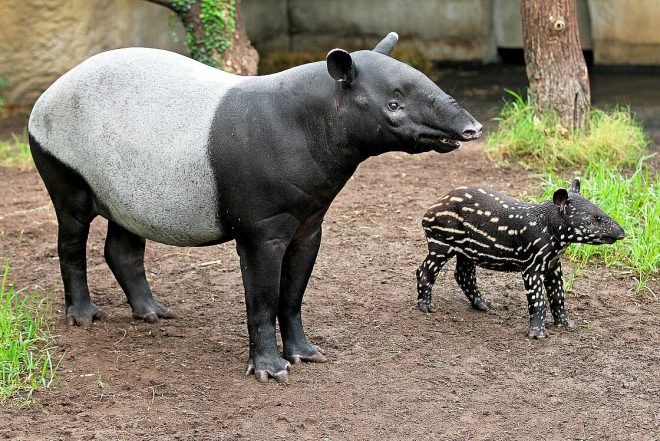
Today, we’re diving into some of the most common myths and misconceptions about the Malayan tapir. Whether you’ve heard about them from a nature documentary or a friend who’s obsessed with wildlife, it’s essential to set the record straight. You see, tapirs are unique creatures with fascinating behaviors and characteristics that deserve our attention. Let’s clear up any confusion and learn more about these gentle herbivores.
Myth 1: Tapirs Are Related to Pigs
One of the biggest myths about the Malayan tapir is that they’re closely related to pigs. While it might seem like a logical connection due to their stout bodies and short legs, here’s the thing: tapirs belong to a completely different group of mammals known as perissodactyls. This group includes horses and rhinos, making them more like distant cousins than siblings of pigs.
Tapirs and pigs do share some physical traits, mainly because they both evolved to thrive in similar environments. For instance, both animals are excellent foragers, using their snouts to rummage through leaves and mud. However, tapirs have distinct adaptations, such as their long, flexible snouts that can grasp leaves—perfect for reaching high into trees or sniffing out tasty roots in the ground. So, while they might look similar at first glance, tapirs are fascinating creatures with unique histories.
Myth 2: They Are Dangerous Animals
If you hear someone say that the Malayan tapir is dangerous, you might raise an eyebrow. Honestly, tapirs are not aggressive creatures. They tend to be shy and reclusive, preferring to avoid confrontation whenever possible. Although they’re large—often weighing between 500 to 800 pounds—they’re herbivores, munching on leaves, fruits, and bark.
When threatened, a tapir’s natural instinct is to make a run for it rather than fight. They are great swimmers, often diving underwater to escape danger. Imagine being in a pool party, and instead of facing the crowd, you just dive in and swim away. That’s like a tapir! So, while their size might intimidate some, they’re more likely to shy away from humans than charge at them.
Myth 3: Tapirs Only Live in the Rainforest
You might think that the Malayan tapir calls only rainforests home, but that’s a misconception. They actually thrive in various habitats! While it’s true that they are often found in tropical rainforests, these adaptable animals can also live in swamps, grasslands, and even mountainous terrains.
Imagine if you had the ability to enjoy both the beach and the mountains on vacation. Tapirs are similar; they can roam in diverse environments as long as there’s plenty of vegetation. They prefer areas close to water sources since they love to cool off and find food near rivers and streams. So, while the rainforest may be their first choice, they can be spotted in many different ecosystems.
Myth 4: Tapirs Are Introverts Who Hate Socializing
You might picture tapirs as the introverted types at a party who’d rather hang in the corner. But here’s the truth: they are not as solitary as you might think! While they do enjoy their alone time, especially during the day when they rest in dense cover, they’re known to be quite social at night.
Tapirs can often be found foraging together in small groups, especially mothers with their young. They have distinctive vocalizations, ranging from grunts and whistles to snorts, which they use to communicate with each other. Think of it as their own social network! These social behaviors are essential for bonding, especially for mothers caring for their offspring, which enhances their survival chances in the wild.
Myth 5: Malayan Tapirs Have No Natural Predators
You might be surprised to learn that Malayan tapirs do have natural predators! While they are hefty animals, young tapirs are particularly vulnerable to large carnivores such as tigers and crocodiles. Imagine being a young tapir, navigating the obstacles of the wild; it can be a bit nerve-wracking with predators lurking around.
Adult tapirs are better protected due to their size and strength, but they must still be aware of potential threats. Their primary defense mechanism is their remarkable ability to blend into their surroundings. The black-and-white coloring helps them camouflage amidst the shadows of the forest. So, while they might seem safe, they still have to stay alert to survive.
Myth 6: Tapirs Are Extinct or Endangered
There’s often confusion around the conservation status of the Malayan tapir. While they are not extinct, they are indeed endangered. This status stems from habitat loss due to deforestation and human activity, such as agriculture and urban development, rather than a lack of existing species.
Efforts are underway to protect their habitats and raise awareness about their plight. Organizations and zoos are working to conserve this species, ensuring that future generations can enjoy the beauty of the Malayan tapir. You might be wondering how you can help—supporting wildlife conservation efforts, spreading awareness, and visiting wildlife parks can all make a difference!
The Malayan tapir is a remarkable animal often surrounded by myths and misconceptions. By peeling back the layers of these myths, we can appreciate the unique qualities of these gentle creatures. They’re much more than just oversized pigs or shy wallflowers; they are vital parts of their ecosystems, facing real challenges in the wild.
Let’s celebrate the Malayan tapir and remind ourselves of the importance of protecting these beautiful animals. Every bit of knowledge helps break down the myths, and every effort counts in ensuring that future generations will encounter these fascinating creatures in the wild.

